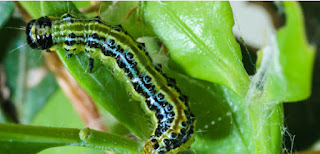Host Plants:
In the garden: Boxwoods
Where Found:
Asia, Europe, and newly arrived in Canada and the US
Description:
Adults are attractive brown or brown and cream moths with a tuft of fur near the backs of their heads, with a wingspan of 1.5 to 1.75 inches (4 to 4.5 cm). Larval caterpillars have shiny black heads and longitudinal green and black stripes. Each of the caterpillar's body segments include white hairs, and markings that look like a pair of eyes. The larvae are found on leaf undersides, often with webbing that protects them from the elements.
Damage:
Young boxwood moth caterpillars rasp green tissue from leaf undersides so the leaves appear peeled. Older larvae skeletonize entire leaves. Persistent feeding weakens boxwoods, causes unsightly brown patches, and may kill weak plants.
Preventing Problems:
Carefully inspect new boxwoods before planting them, because this pest has secretly spread in nurseries. As a safety precaution, treat new boxwoods with a Bacillus thruingiensis-based organic pesticide if any leaves show feeding damage.
Managing Outbreaks:
Wrap the end of a stick with outward-facing tape and use it to loosen and gather actively feeding caterpillars by swirling up webbing with the sticky end. Immediately treat plants with an organic pesticide with Bacillus thuringiensis or Spinosad as its active ingredient, taking care to cover leaf undersides. Repeat after 10 days to kill small larvae that may have hatched. In most areas this pest should be reported to local agricultural authorities, who may use pheromone traps to monitor or capture highly localized outbreaks.





0 comments
إرسال تعليق